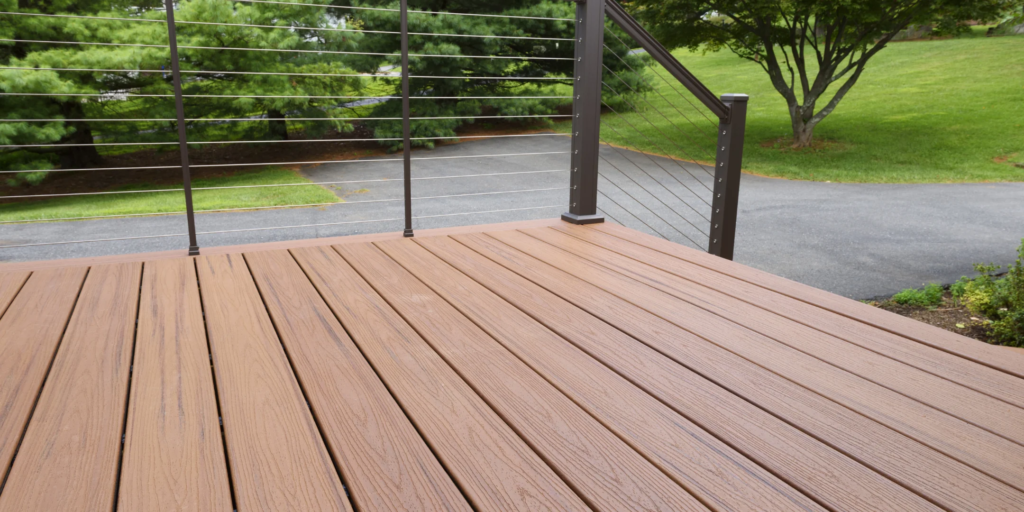
When your deck starts showing signs of wear and tear, it can be disheartening. Whether it’s peeling paint, faded colors, or weathered wood, a deteriorating deck can detract from the beauty and functionality of your outdoor living space. Instead of completely replacing your deck, consider deck resurfacing as an effective and cost-efficient solution to revitalize your deck and extend its lifespan.
What is Deck Resurfacing?
Deck resurfacing involves applying a new surface layer over the existing deck to cover up damage, imperfections, or aging. Unlike a complete deck replacement, which involves removing and rebuilding the entire structure, resurfacing is a quicker and more affordable way to refresh your deck without the hassle of a full-scale renovation.
Resurfacing works by covering the old surface with high-quality materials, such as composite decking boards or specialized coatings, to restore the deck’s appearance and enhance its durability. The process not only improves the aesthetics but also reinforces the deck to withstand the elements for years to come.
Benefits of Deck Resurfacing
1. Cost-Effective Solution
One of the most significant advantages of deck resurfacing is its affordability compared to full deck replacement. If your deck is structurally sound, resurfacing can be done at a fraction of the cost of tearing down and rebuilding. It’s an excellent choice for homeowners who want to save money while still giving their deck a fresh look.
2. Quick and Convenient
Replacing a deck can take several weeks or even months, depending on the size and complexity of the project. In contrast, resurfacing typically takes only a few days, allowing you to get back to enjoying your outdoor space in no time. You won’t have to deal with the mess and disruption of a full deck replacement, making it a more convenient option.
3. Environmentally Friendly
Resurfacing helps reduce the environmental impact of construction waste. Rather than tearing down an old deck and sending it to a landfill, resurfacing allows you to reuse the existing structure, reducing waste and preserving valuable resources. This eco-friendly option is a great way to minimize your carbon footprint.
4. Enhanced Durability
Modern resurfacing materials, such as composite decking, are designed to withstand harsh weather conditions, resist fading, and require little maintenance. By resurfacing your deck with these materials, you can ensure that it remains durable and beautiful for years to come. Composite decking, in particular, is resistant to mold, mildew, and insect damage, which means your deck will stay in top condition with minimal effort on your part.
When to Consider Deck Resurfacing
Deck resurfacing is ideal when the underlying structure of your deck is still in good condition, but the surface shows signs of wear. If your deck is structurally compromised with significant rot, cracks, or instability, resurfacing may not be sufficient, and a complete replacement might be necessary.
Signs that your deck may be a good candidate for resurfacing include:
- Fading or peeling paint or stain
- Minor cracks or splinters on the surface
- Discoloration due to weathering
- Loose or warped decking boards
- Unstable railings or support structures
If these issues are confined to the surface and the deck frame remains sturdy, resurfacing can bring your deck back to life without the need for a full rebuild.
The Deck Resurfacing Process
The resurfacing process typically involves several steps to ensure a smooth and lasting finish. Here’s a brief overview of the general steps involved:
1. Inspection and Preparation
Before resurfacing, a thorough inspection of the deck is necessary. A professional contractor will check for any underlying structural issues, such as loose screws, nails, or unstable boards. The deck surface will also be cleaned to remove dirt, grime, and any old coatings.
2. Surface Repair
If there are any minor imperfections, such as cracks or gaps between boards, they will be repaired during this stage. This ensures a smooth and even surface for the new decking material to be applied.
3. Resurfacing Application
Once the surface is prepped, the new decking material is applied. This could be a composite decking material or a special coating designed to improve the deck’s appearance and durability. Depending on the product chosen, the process may involve applying adhesives, nails, or screws to secure the new surface.
4. Finishing Touches
After the resurfacing material is in place, the deck is inspected to ensure everything is securely attached and level. Railings and steps may also be updated or replaced as part of the resurfacing process. Finally, the deck is thoroughly cleaned to remove any debris and prepare it for use.
Conclusion
Deck resurfacing is a fantastic option for homeowners who want to breathe new life into their outdoor space without breaking the bank. With its cost-effectiveness, quick turnaround time, and ability to enhance durability, resurfacing is a smart choice for many. If your deck has become worn out but is still structurally sound, resurfacing can provide a fresh look while adding years of life to your deck.





Leave a Reply